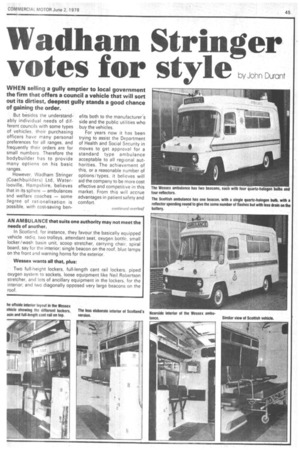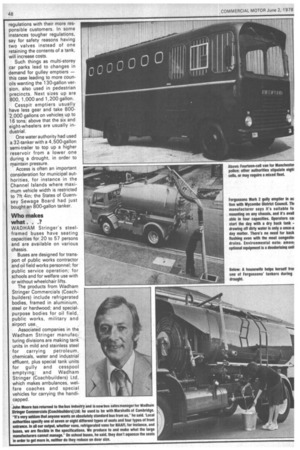Wadham Stringer votes for style
Page 47

Page 48

Page 49

Page 50

If you've noticed an error in this article please click here to report it so we can fix it.
by John Durant
WHEN selling a gully emptier to local government the firm that offers a council a vehicle that will sort out its dirtiest, deepest gully stands a good chance of gaining the order.
But besides the understandably individual needs of different councils with some types of vehicles, their purchasing officers have many personal preferences for all ranges, and frequently their orders are for small numbers. Therefore the bodybuilder has to provide many options on his basic ranges.
However, VVadham Stringer (Coachbuilders) Ltd, Waterlooville, Hampshire, believes that in its sphere — ambulances and welfare coaches — some Jegree of rationalisation is possible, with cost-saving ben efits both to the manufacturer's side and the public utilities who buy the vehicles.
For years now it has been trying to assist the Department of Health and Social Security in moves to get approval for a standard type ambulance acceptable to all regional authorities. The achievement of this, or a reasonable number of options/types, it believes will aid the company to be more cost effective and competitive in this market. From this will accrue advantages in patient safety and comfort. "At present, by the way, we are facing unfair competition from a company in Southern Ireland," said Gareth Haylett, Wadham Stringer (Coach builders) general manager. "On top of that Southern Ireland is operating a tax holiday on ex port profits. We have protested to all the appropriate government departments."
Not that Mr Haylett's company is doing badly in this field.
orders for ambulances and wel
fare buses amount to £21/2m. In fact there,is something of a new
broom sweeping through the company. He has come into the industry from the motor caravan field only in the last six months. Divisional designer/engineer Howard Chapman joined from Jaguar cars six months ago.
Mr Haylett is very appreciative of the expertise and enthusiasm to be found in the company. "But the needs of the consumer in design styling is one of paramount importance." he says.
"The bus world in particular has been backward in meeting individual needs. There are many dull and uninteresting designs in the industry. We are aiming to put a bit of style and flair into bus design on top of safety.
"We want to move into the single-decker bus market in cluding ow, so we are moving into all-metal bodies. And we mean to build up our welfare bus side; it is a particularly growing market.
-The company is developing a more aggressive export policy.
We want to export singledeckers, and for markets such as West Africa we must have allsteel-bodied vehicles."
The company has just invested in a £30,000 vacuum forming machine which will allow more attractive design details for such things as plant-on pieces to be designed — and at an economical cost.
Mr Chapman extolled the virtues of ARC (active ride con trol) pneumatic/hydraulic springing, for which Wadham Stringer combined with Automotive Products on its development for on-road use in order to offer it as an option for ambulances.
"Van chassis ambulances are tremendously improved by this," he said. "Unfortunately, not enough local authorities are taking it up. For about £2,500 it greatly improves patient com fort and therefore safety. It greatly increases speed to the scene of an accident and is also invaluable if, for instance, an ambulance driver has to negotiate cart tracks and other rough terrain when picking up a patient."
Transport managers add expertise to council buying OVER at Fergussons — "the tanker people— at Limberline Road, Hilsea, Portsmouth, there was good news for transport managers. Those of you in local
government, gentlemen, have brought a wind of change to council buying.
"Now all councils have a transport manager: someone who talks our language,says Michael Sibbick, general sales manager of Fergussons Tankers Ltd.
"We can talk to him about our vehicles' advantages, but he must be strong enough to convince committees of local councillors who don't know anything about vehicles.
"If he is strong enough he can have what he wants within a reasonable cost. There are many variations available on the theme. Local authorities by and large are conservative and stick with the devil they know. However, local authorities are now much more professionally looked after. And now, too, a truly personal touch is coming in
-Ours is a competitive business and all companies have their own ideas on, for instance, how gullies should be emptied."
The company sells around two to three gully /cesspool emptiers a month to local authorities, and this side of the business in volume is far outstripped by the fuel oil side.
However, the company believes there will be a fair amount of expansion on the municipal side. A lot of waste is disposed of by private contractors, so there is a considerable sale here.
These municipal vehicles last a lot longer than commercials — say 10 years.
When their useful life with local authorities is over, small waste oil collectors pick them up sebond-hand as cheap vacuum tankers. Many end up in Ireland.
He feels certain that legislation will come allowing a bigger gross vehicle weight and says the company must be ready to put bigger tanks on its chassis.
They don't intend to build in aluminium, however, but may consider developing stainless steel, though only for the industrial side.
They are planning to be ahead of the competition, particularly by being ready for new legislation by construing draft regulations with their more responsible customers. In some instances tougher regulations, say for safety reasons having two valves instead of one retaining the contents of a tank, will increase costs.
Such things as multi-storey ,car parks lead to changes in demand for gulley emptiers — this case leading to more councils wanting the 130-gallon version, also used in pedestrian precincts. Next sizes up are 800,1,000 and 1,200 gallon.
Cesspit emptiers usually have less gear and take 800
2,0O0 gallons on vehicles up to 16 tons; above that the six and eight-wheelers are usually industrial.
One water authority had used a 32-tanker with a 4,500-gallon semi-trailer to top up a higher reservoir from a lower one during a drought, in order to maintain pressure. Access is often an important consideration for municipal authorities, for instance in the Channel Islands where maximum vehicle width is restricted to 7ft 4in; the States of Guernsey Sewage Board had just bought an 800-gallon tanker.
Who makes what. . .?
WADHAM Stringer's steelframed buses have seating capacities for 20 to 57 persons and are available on various chassis.
Buses are designed for transport of public works contractor and oil field works personnel; for public service operation; for schools and for welfare use with or without wheelchair lifts.
The products from Wadham Stringer Commercials (Coachbuilders) include refrigerated bodies, framed in aluminium, steel or hardwood; and specialpurpose bodies for oil field, public works, military and airport use.
Associated companies in the Wadham Stringer manufacturing divisions are making tank units in mild and stainless steel for carrying petroleum, chemicals, water and industrial effluent, plus special tank units for gully and cesspool emptying; and Wadham Stringer (Coachbuilders) Ltd, which makes ambulances, welfare coaches and special vehicles for carrying the handicapped.








































































































































